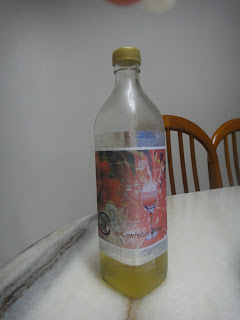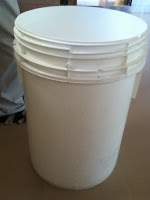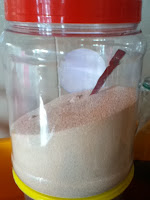
The fermentation process lasted about 3 to 5 days. On the fourth day, we opened the air-lock and gave the fermented mash a thorough stir and resealed it so that the brandy could clear up by allowing the sediment to settle down at the bottom. This sedimentation process took another 5 to 7 days. The alcohol content was measured by an alcohol meter which appeared that the mash only had about 8 to 9% of alcohol.


Burning with curiosity on how will Rambutan wine turn out to be, we scooped up the top part carefully so as to not disturb the sediment and placed in a separate container. We added egg white as our fining agent. Referring to a winemaking website, egg white is an excellent fining agent for removing haze caused by excessive tannin. I will include the directions on preparing the fining agent. The steps are very simple, which is to separate an egg and gently beat the white in a small amount of the unclarified wine. C.J.J. Berry insists that one must add a pinch of salt to the white before beating it. Use approximately half the beaten white egg for every 5-gallon carboy. (A carboy is a rigid container with a typical capacity of 5 to 15 gallons (20 to 60 L).) Simply pour the beaten egg white into the wine and stir well with a long sterilized rod. Refit the airlock and set aside for ten days. The wine should clarify.


For the rest, we decided to use distillation. Here is our "homemade" distilling equipment, which was modified to save costs. Do not worry if the product quality would be affected, this machine works exactly the same. The only issue is that, it can only distill small batches.
After the first still, the results showed about 45% of alcohol. In order to obtain 80% alcohol, I have done some simple calculations.
What we have: 5Liters * 9% alcohol = 45%
What we wish to obtain: 80% alcohol. So I took 45/80 = 0.5Liters.
Based on calculations, we will only obtain 0.5Liters of Rambutan brandy if we want to achieve 80% alcohol. We redistilled the first still to get a higher alcohol level of brandy. I am really excited to see the clarity and transparency of the first still. It had the aroma that tantalize nostrils with the scent of juicy fresh "peaches".



This is the effect after adding fining agent. However, it still need to take a while for further clarification.
Making pure alcoholic beverage can be costly, so it is wise to not purchase cheap beverages if good quality is preferred.

























